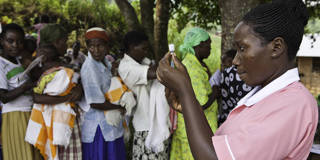From labor shortages to racial bias, the barriers to achieving Sustainable Development Goal 3 – “ensure healthy lives and promote well-being for all at all ages” – are as diverse as they are high. But the chances of success are significantly better if we listen to those who understand the situation on the ground.
ABUJA – We have a decade left to achieve the United Nations Sustainable Development Goals (SDGs), and we are nowhere near where we need to be to succeed. One crucial reason is that women remain largely excluded from decision-making processes, which leads to policies that do not provide women the support they need to prosper – or even to survive. Nowhere is this dynamic more apparent than in the health sector.
Women comprise roughly 70% of the global health workforce, and perform the majority of the sector’s most challenging, dangerous, and labor-intensive jobs. Yet they hold only 25% of the health sector’s senior roles, and are rarely represented adequately in policymaking. Instead, they are often expected to remain passive actors, quietly finding ways to do their jobs in difficult – even impossible – circumstances.
The reality for women health workers was reflected in a recent letter to the medical journal The Lancet from two Chinese nurses describing the conditions they and their colleagues face on the frontlines of the battle against the new coronavirus, COVID-19, at its source in Wuhan, China. It may be an extreme case (and the letter has now been retracted over claims that it was not a firsthand account), but the challenges described, from shortages of protective equipment to chronic overwork and exhaustion, are all too familiar to health workers everywhere.

ABUJA – We have a decade left to achieve the United Nations Sustainable Development Goals (SDGs), and we are nowhere near where we need to be to succeed. One crucial reason is that women remain largely excluded from decision-making processes, which leads to policies that do not provide women the support they need to prosper – or even to survive. Nowhere is this dynamic more apparent than in the health sector.
Women comprise roughly 70% of the global health workforce, and perform the majority of the sector’s most challenging, dangerous, and labor-intensive jobs. Yet they hold only 25% of the health sector’s senior roles, and are rarely represented adequately in policymaking. Instead, they are often expected to remain passive actors, quietly finding ways to do their jobs in difficult – even impossible – circumstances.
The reality for women health workers was reflected in a recent letter to the medical journal The Lancet from two Chinese nurses describing the conditions they and their colleagues face on the frontlines of the battle against the new coronavirus, COVID-19, at its source in Wuhan, China. It may be an extreme case (and the letter has now been retracted over claims that it was not a firsthand account), but the challenges described, from shortages of protective equipment to chronic overwork and exhaustion, are all too familiar to health workers everywhere.